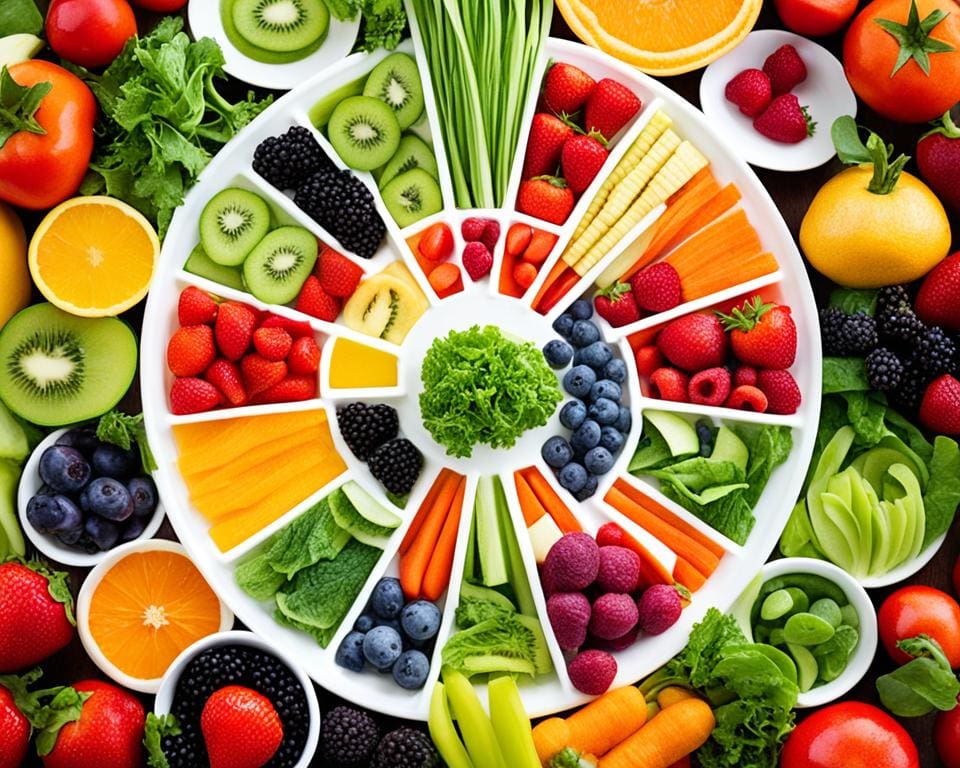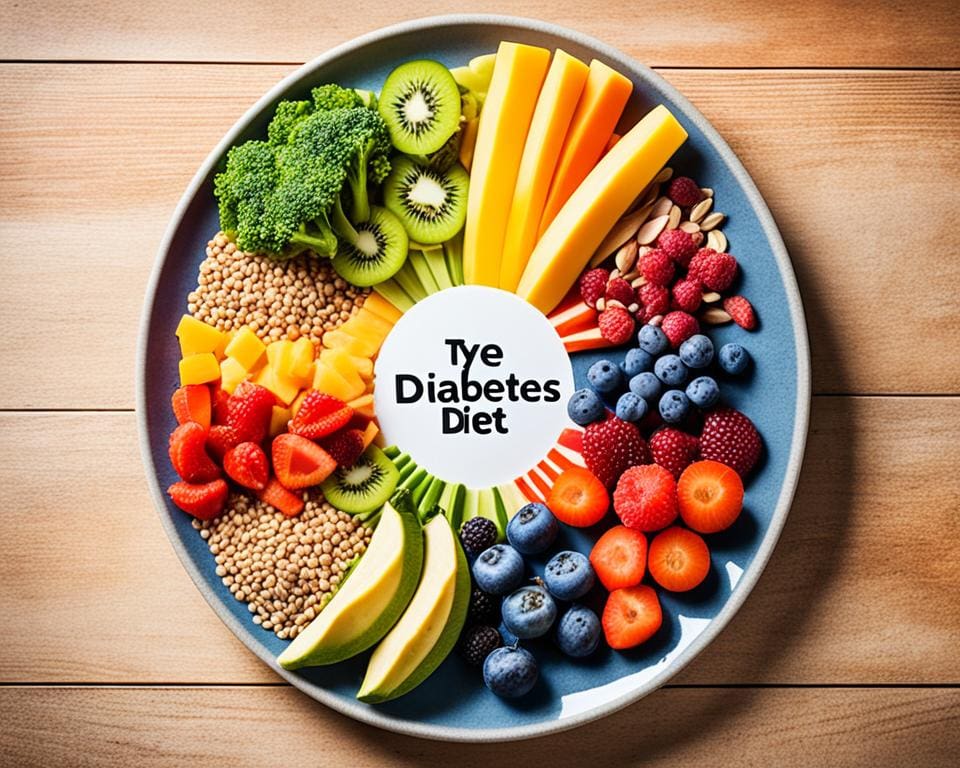Looking for desserts that are good for your health? Then you’re in the right place! In this article, we reveal how you can enjoy tasty treats without the extra serving of guilt by baking healthy desserts with low-carb and sugar-free ingredients that are good for your blood sugar.
Creating diabetic-friendly desserts is all about using the right ingredients. Almond flour, for instance, has fewer carbs than regular flour3. Sugar substitutes like stevia and erythritol add sweetness without affecting blood sugar5. This means you can enjoy treats like sugar-free chocolate brownies that are both tasty and won’t spike your blood sugar3.
The Importance of Low-Carb and Sugar-Free Options
For those with diabetes, choosing low-carb and sugar-free desserts is key. These treats help manage blood sugar levels, so you can enjoy sweets without worrying about spikes5. Recipes often use healthy fats like almond butter and coconut oil to help keep blood sugar stable3. Ingredients like chia seeds and flaxseed also help control blood sugar levels3.
The low carbohydrate and high protein profiles of diabetes-friendly desserts help manage glucose and provide energy all day3.
Looking for a quick dessert or something to share? There are many delicious diabetic desserts out there. From sugar-free fudge to devil’s food snack cake for 24 people4, there’s something for everyone. These desserts show how you can enjoy rich flavors without worrying about your blood sugar3.
What is Diabetes?
Diabetes is a long-term condition that affects how your body uses glucose, or sugar. If you have diabetes, your body might not make enough insulin or use it well. This leads to high blood sugar levels. But, there are many tasty diabetic dessert ideas that can satisfy your sweet tooth without harming your health.
Explanation of diabetes types (Type 1, Type 2)
Type 1 diabetes is when your body attacks and destroys insulin-making cells. It often starts in childhood and needs daily insulin shots. Type 2 diabetes, more common, happens when your body doesn’t use insulin well or makes too little. It’s linked to obesity, not moving enough, and bad diet6.

Importance of diet in diabetes management
When you have diabetes, what you eat is very important. Eating foods rich in healthy fats, lean proteins, and fiber helps keep blood sugar stable. For sweet treats, pick desserts that are low in sugar and carbs. For instance, a flourless brownie has just 7 grams of sugar and 11 grams of carbs per serving7.
By choosing wisely and eating in moderation, you can enjoy yummy desserts while managing your diabetes well. Recipes like no-bake peanut butter balls and dark chocolate nut bark are good choices. They have less sugar and carbs, fitting into a diabetic diet. These treats usually have 7 grams of sugar or less and 5 to 16 grams of carbs7.
“Life is uncertain. Eat dessert first.” – Ernestine Ulmer
With creativity and the right ingredients, you can make many tasty diabetic desserts. These treats will satisfy your sweet tooth without harming your health. The secret to managing diabetes is finding a balance that fits your life.
The Role of Carbohydrates and Sugars
Managing diabetes means knowing how carbs and sugars affect blood sugar. Carbs turn into glucose, which changes blood sugar levels. This is key for diabetes care8. Too many carbs, like refined ones, can cause blood sugar to rise too high8.
The American Heart Association says women should have no more than 25 grams of added sugar daily. Men should not have more than 36 grams9. But, a can of Coca-Cola has 39 grams, more than the daily limit for both men and women9. Also, 8 ounces of fruit juice has as much sugar as 8 ounces of soda10. It’s important to limit sugary drinks and snacks to manage blood sugar810.

For those with prediabetes or diabetes, keeping added sugar intake under 10% of daily calories is advised9. The American Diabetes Association suggests a meal plan. Non-starchy veggies should be 50% of your plate, and starchy carbs like fruits and whole grains should be 25%8. Foods like broccoli and tomatoes are low in carbs but high in fiber, which helps keep blood sugar stable8.
How Carbs and Sugars Affect Blood Sugar Levels
Foods with simple sugars digest faster, causing blood sugar to rise quickly9. It’s best to avoid refined carbs and added sugars in your diet8. Instead, choose fruits like apples and blueberries, and whole grains like brown rice and oatmeal8.
When making sugar-free desserts or low-carb desserts for diabetics, use sweeteners carefully. Sugar alcohols have fewer calories than sugar but can add to calorie intake9. Stevia and monk fruit are safer alternatives to artificial sweeteners, as they are GRAS9.
Recommended Daily Intake for Diabetics
The American Diabetes Association suggests checking blood sugar levels often to see how carbs affect it10. Eating three main meals a day helps keep blood sugar stable10. A serving of fruit is one small apple or orange, half a large banana, or one cup of cubed melon10.
Eating foods with lower glycemic indices, like whole grains, can help manage blood sugar. Foods high in fiber are also good for blood sugar levels.
Understanding carbs and sugars in diabetes management helps make better choices for diabetic-friendly desserts. Focus on whole, unprocessed ingredients and watch portion sizes to control blood sugar.
Key Ingredients for Diabetic Desserts
Making tasty diabetic desserts is easy with the right stuff. Use low-carb sweeteners like stevia and erythritol instead of sugar. This way, you can enjoy sweet treats without harming your health11.
These natural sweeteners are great for low-sugar recipes. Some desserts have as little as 2g of sugar per slice11.
Whole grain flours like almond and coconut flour are also key. They’re perfect for keto recipes, which cut down on carbs11. Add healthy fats like coconut oil and avocado for better texture and taste.

Fruits add natural sweetness and fiber to desserts. Use fruits like blueberries and bananas for flavor without too much sugar11. They make your desserts taste amazing and are good for you12.
Choose low-fat or sugar-free dairy like Greek yogurt and almond milk. These help make creamy desserts like cheesecakes and puddings that are lower in carbs and calories. Many of these desserts are great for sharing, with sizes for 8 to 12 people12.
The key to success with diabetic desserts is finding the right balance of ingredients that satisfy your cravings while supporting your health goals.
With these ingredients, you can make lots of tasty treats that fit your diet. Try sugar-free fudge, low-carb brownies, and pumpkin spice cake. There are endless options for delicious diabetic desserts12.
Low-Carb Sweeteners
Creating tasty diabetic cake recipes is easier with low-carb sweeteners. They help keep blood sugar stable. With over 31 million Americans with diabetes and more than one in three at risk, finding good sweeteners is key13.
Natural sweeteners like stevia, erythritol, xylitol, and monk fruit extract are great for sweet treats. They don’t raise blood sugar much. Recipes like the ginger plum tart, which serves 8 and takes 35 minutes to make14, use these sweeteners for tasty flavors.

Stevia
Stevia comes from the stevia plant and is very sweet. A little goes a long way. It’s good for baking, drinks, and even savory dishes, adding sweetness without carbs.
Erythritol
Erythritol is a sugar alcohol found in fruits like pears and watermelons. It has a low glycemic index and doesn’t raise blood sugar much. It’s a great choice for diabetic cakes, as it can replace sugar 1:1 in most recipes.
Xylitol
Xylitol is a sugar alcohol from corn or birch wood. It’s as sweet as sugar but has fewer calories and carbs. But, eating too much can cause a laxative effect.
Monk Fruit Sweetener
Monk fruit extract comes from a melon in Southeast Asia. It’s very sweet and has no calories or carbs. It’s perfect for diabetic desserts. But, it’s often mixed with other sweeteners like erythritol to balance its intensity.
“I love using low-carb sweeteners in my diabetic cake recipes. They allow me to enjoy sweet treats without worrying about my blood sugar levels.”
Diabetics can enjoy desserts like the devil’s food snack cake, which serves 24 and takes over an hour to make14. Eating smaller portions and watching carb counts helps keep blood sugar stable while satisfying cravings13.
Nut Flours
When baking diabetic cookie recipes, nut flours are a game-changer. They are low in carbs but high in fiber, protein, and healthy fats. This makes them great for people with diabetes.

Almond flour is a hit among keto bakers. It can replace cake flour one-to-one, making it very versatile15. A single almond flour cake has only 3 grams of carbs, with 1 gram of net carbs. It also has 5 grams of protein and 9 grams of fat, fitting the ketogenic diet well15.
Almond Flour
Almond flour shines in making tasty, diabetic-friendly treats. For example, almond flour pancakes have about 5 grams of carbs16. Two pancakes have 9.7 grams of carbs and 2.1 grams of sugar16. Plus, you get 8 pancakes from one batch, perfect for breakfast16.
Coconut Flour
Coconut flour is great for low-carb baking. It adds a unique texture and a hint of coconut flavor. Mixing it with dates, sunflower seed butter, and dark chocolate chips makes delicious cookie dough bars17. A recipe with 192 grams of almond flour and 64 grams of sunflower seed butter makes 16 bars in an 8×8 pan17.
Hazelnut Flour
Hazelnut flour is a hidden gem. It adds a rich, nutty flavor to desserts. It’s perfect for chocolate-hazelnut biscotti or hazelnut chocolate chip cookies.
Nut flours are a true blessing for those looking to indulge in sweet treats while managing their diabetes. With a little creativity and the right ingredients, you can create a world of delicious, low-carb desserts that everyone will love.
Using nut flours like almond, coconut, and hazelnut in your baking is a smart move. It leads to guilt-free, diabetic-friendly desserts that taste amazing. So, preheat your oven and let’s bake!
Dairy Alternatives
When making healthy diabetic treats, dairy alternatives are key. They add creaminess without the sugar and fat of regular milk or cream. These options are great for those with diabetes, lactose intolerance, or a vegetarian diet. They show a growing need for different ingredients in desserts18.

Popular choices for diabetic desserts include unsweetened almond milk, coconut cream, and Greek yogurt. They’re perfect for no-bake pies, mousses, and puddings. They offer a creamy texture and keep sugar levels low. Greek yogurt also adds protein to your desserts.
Unsweetened Almond Milk
Unsweetened almond milk is great for cutting down carbs. It has a mild nutty taste and is low in calories. Make sure to choose unsweetened almond milk to avoid added sugars.
Coconut Cream
Coconut cream adds a rich, tropical flavor to desserts. It’s thick and perfect for ice creams, puddings, and frostings. Coconut cream is high in fat but contains healthy MCTs that are easily digested19.
Greek Yogurt
Greek yogurt is very popular for good reasons. It’s packed with protein and can replace sour cream or regular yogurt in desserts. Its tangy taste and creamy texture are great for healthy diabetic treats like cheesecakes and parfaits. Choose plain, unsweetened Greek yogurt to keep sugar low19.
“I love using Greek yogurt in my diabetic-friendly desserts. It adds a delightful creaminess while keeping the carb count in check. Plus, the extra protein keeps me feeling satisfied for longer!”
Using dairy alternatives in diabetic desserts lets you enjoy tasty treats without harming your health. Try different mixes to find the perfect flavor and texture. With creativity and the right ingredients, you can make many healthy diabetic treats that are both delicious and good for you.
Healthy Fats
Healthy fats are key in making diabetic-friendly sweets. They add satisfaction and help keep blood sugar stable. Unlike desserts with butter or shortening, these fats are better for you20. Coconut oil, nut butters, and avocado are great for adding flavor without harming your health.

Coconut oil is special because of its MCTs. These fats are easy to digest and turn into energy, not fat21. Nut butters, like almond and peanut butter, mix healthy fats, protein, and fiber. They’re perfect for sweet treats20.
Avocado is a superfood great for diabetic desserts21. Its creamy texture and mild flavor make recipes like chocolate mousse or brownies better. Avocado’s healthy fats also slow down sugar absorption, keeping blood sugar stable20.
A little goes a long way when it comes to healthy fats in diabetic-friendly sweets. Moderation is key to striking the perfect balance between indulgence and well-being.
Coconut Oil
Coconut oil is versatile in diabetic desserts. It’s great as a butter substitute or drizzled over berries. It adds a tropical flavor and provides MCTs21. Try making molasses crinkle cookies with coconut oil for a treat that won’t raise your blood sugar22.
Nut Butters (Almond, Peanut)
Nut butters add healthy fats, protein, and fiber to diabetic-friendly sweets. Almond butter and peanut butter are good in smoothies and baked goods. A no-bake apple pie is a tasty example, blending nut butter with fruit sweetness22.
Avocado
Avocado is a surprising but great addition to desserts. Its creamy texture and mild flavor work well in many sweet dishes. For example, a chocolate avocado mousse can be made in 5 minutes with six ingredients. It’s gluten-free and diabetic-friendly, and people love it21.
Using healthy fats in diabetic desserts lets you enjoy tasty treats without harming your health. Just remember to eat in moderation and check with your doctor to make sure these desserts fit your health plan.
Example Diabetic Dessert Recipes
Finding easy diabetic desserts that are sweet and safe for your blood sugar can be tough. But, with some creativity and the right ingredients, you can make many tasty and healthy desserts23. Try making elegant tiramisu, pumpkin trifle, or even grilled pineapple with a spicy twist.

Looking for desserts that are good for diabetics, you’ll find many recipes. They serve from 2 to 64 people, with most making 12 servings24. Prep times vary, from just 10 minutes to over an hour, based on the recipe’s complexity2324. Some, like Devil’s Food Snack Cake and Pear Tart, skip frosting to cut down sugar and highlight natural sweetness23.
Adding ingredients like fresh fruits, Greek yogurt, and chia seeds can make your desserts healthier. For instance, a cup of mixed berries has 6g of fiber and 10g of sugar. Greek yogurt adds more protein than regular yogurt25. Baking apples are sweet without extra sugar, perfect for easy diabetic desserts25.
“Life is uncertain. Eat dessert first.” – Ernestine Ulmer
When making diabetic desserts, watch your portion sizes and carb content. Some recipes have a bit of sugar, but it’s key to match your portions to your carb goals25. Enjoying each bite mindfully lets you have a sweet treat without harming your health.
No-Bake Cheesecake
Looking for a delicious diabetic dessert that’s easy to make and doesn’t require turning on the oven? Look no further than this creamy and indulgent no-bake cheesecake! It has a smooth, sugar-free filling and a crunchy almond flour crust. This cheesecake is perfect for anyone following a low-carb or keto diet.
This no-bake cheesecake recipe yields 12 slices, each containing just 3g net carbs, 249 kcal, 5.2g carbohydrates, 5.3g protein, 23.5g fat, 2.2g fiber, and 2.1g sugar26. It’s a guilt-free indulgence that you can enjoy without compromising your health goals.
Ingredients
The ingredients for this no-bake cheesecake are simple and wholesome. The crust is made with 150g almond meal/flour, 55g melted butter, and 50g unsweetened desiccated/shredded coconut26. The creamy filling consists of 500g full-fat cream cheese, 4 tbsp lemon zest, 2 tbsp lemon juice, and granulated sweetener to taste26. To achieve the perfect consistency, 12g of powdered gelatin is mixed with 200ml boiling water and 200ml cold water26.
Preparation Steps
Preparing this no-bake cheesecake is a breeze. Start by mixing the crust ingredients and pressing the mixture into a lined springform pan. Refrigerate for 1-2 hours to set26. While the crust sets, mix the gelatin with boiling and cold water, then combine with the cream cheese, lemon zest, lemon juice, and sweetener using an electric mixer on slow speed26. Pour the filling over the crust and refrigerate for 12 hours or overnight until firm27.
This no-bake cheesecake is a game-changer for anyone looking for a delicious diabetic dessert that’s easy to make and doesn’t compromise on taste or texture.
Nutritional Information
One serving of this no-bake cheesecake contains just 238 kcal, 3g carbohydrates, 3g protein, 25g fat, and 1g fiber27. It’s a low-carb treat that fits perfectly into a diabetic-friendly diet. You can enjoy this cheesecake guilt-free, knowing that it’s made with wholesome ingredients and contains no added sugar.
This no-bake cheesecake can be stored in the fridge for 4-5 days2627 or frozen for 2-3 months26. It’s a versatile dessert that can be enjoyed on its own or topped with fresh berries or a sugar-free coulis made with 1 ½ cups frozen or fresh berries, ¼ cup water, and 1-2 tablespoons sweetener, simmered for about 5 minutes27.
Chocolate Avocado Mousse
Looking for a tasty and healthy diabetic dessert idea? Try this rich chocolate avocado mousse! It has only 3.8g net carbs and 0.8g sugar per serving. It’s perfect for those watching their sugar intake28.
Avocados are full of vitamins, minerals, and phytonutrients. They have less than 1 gram of sugar per ounce. This makes them the fruit with the least sugar. This recipe mixes avocado’s healthy fats with cocoa powder and a sugar substitute for a delicious dessert29.
Ingredients
To make this mousse, you need 2 large ripe avocados (350g avocado flesh), ½ cup (50g) unsweetened cocoa powder, ½ cup (120g) coconut cream, and ½ cup (60g) powdered sweetener28. For a richer taste, use melted chocolate chips or Dutch cocoa for less fat and sugar29.
Preparation Steps
Blend the avocado flesh, cocoa powder (or melted chocolate chips), coconut cream, sweetener, and almond milk until smooth. Chill it before serving for the best taste and texture. This recipe is quick, taking only 5 minutes to prepare. It makes 6 servings of about 80g each28.
Nutritional Information
Each serving has 157 calories, 10.5g carbs, 2.8g protein, 14g fat, and 6.7g fiber28. It also gives 8% of the daily fiber value, thanks to the avocado29.
With 30 million children and adults in the U.S. with diabetes, and 86 million at risk for type 2, finding healthy desserts is key29.
This vegan avocado chocolate mousse can be kept in the fridge for up to 3 days or frozen for 3 months. It’s a convenient and tasty treat for when you need it28.
Almond Flour Cookies
Try the tasty almond flour cookies for a sweet treat without the sugar. They’re a healthier choice than regular cookies, made with white flour and lots of sugar. Find the recipe for sugar-free desserts here.
These cookies are quick to make, ready in just 5-15 minutes to cook for 8-12 minutes. You’ll get 12-16 cookies, depending on how big you like them3031.
Ingredients
Blanched almond flour is the main ingredient, giving a nutty taste and soft texture. Each cookie has about 90-192 calories, with 2.6-13 grams of carbs and 1.4-11 grams of net carbs3031. They’re also packed with protein, 3.7-4 grams per cookie, and healthy fats from almond flour and coconut oil3031.
Preparation Steps
Start by mixing butter or coconut oil with a sweetener of your choice. Add almond flour, salt, and vanilla extract until a dough forms. Shape into small balls, flatten them, and bake at 180°C (350°F) for 8-12 minutes30.
These cookies are a game-changer for anyone following a low-carb or sugar-free diet. They satisfy my sweet tooth without the guilt!
Nutritional Information
Each cookie weighs about 20 grams and is 5 cm in diameter30. They have 7.7 grams of fat, 1.1 grams of saturated fat, 1.2 grams of fiber, and 0.6 grams of sugar30. They’re also a good source of calcium, with 66 mg per serving, and contain iron and potassium31.
These almond flour cookies are a delicious and nutritious treat that you can enjoy guilt-free. With their crisp and buttery texture, you won’t even miss the traditional sugar-laden cookies. Store them in an airtight container for up to a week, or freeze for up to 6 months31.
Tips for Making Diabetic Desserts
Making tasty low-carb desserts for diabetics is easy. Just follow a few simple tips. You can enjoy sweet treats without hurting your health goals. The trick is to mix flavors, choose ingredients carefully, control portions, and balance desserts with other nutrients.
Try using natural sweeteners like stevia, erythritol, or monk fruit instead of sugar. These sweeteners add sweetness without carbs32. Also, add spices like cinnamon, nutmeg, and vanilla to make your desserts taste great without extra sugar.
Strategic ingredient mixing makes desserts more satisfying and healthy. For example, adding fiber-rich berries or nuts slows down digestion and keeps blood sugar stable32. Using almond butter instead of butter and flour increases protein, making desserts more filling32.
Portion Control
Controlling dessert portions is key for diabetics. Experts say to split desserts to keep carb intake low, aiming for 45-60 grams per meal3233. Cut your treats into small squares or use mini tart pans to enjoy them without overeating.
Small portions are key; dessert sizes should be kept small for better blood sugar control.
It’s also important to balance desserts with other nutrients. Pairing sweet treats with lean proteins and veggies helps manage blood sugar and provides a complete meal32. Successful recipes often include eggs, nuts, and lower-fat dairy for extra nutrition32.
With these tips, making healthy low-carb desserts for diabetics is easy. Mix flavors, choose ingredients wisely, control portions, and balance nutrients. This way, you can enjoy sweet treats without harming your health goals.
Conclusion
Living with diabetes doesn’t mean you have to give up desserts. You can enjoy sweet treats by choosing smart ingredients and watching portion sizes34. Try using almond and coconut flours, stevia, and monk fruit for natural sweetness. Nuts and avocados add healthy fats to your desserts35.
Adding protein, fats, and fiber to your desserts helps keep blood sugar stable34. This prevents sudden spikes in blood sugar levels.
When making diabetic desserts, choose complex carbs like whole grains for fiber34. Greek yogurt or almond flour adds protein, keeping you full and blood sugar levels steady34.
Remember, even healthy desserts should be enjoyed in moderation35. Portion control is important.
Try new flavors and mix ingredients for tasty diabetic desserts. Enjoy no-bake cheesecakes, chocolate avocado mousse, and almond flour cookies. With the right ingredients, you can indulge without guilt. So, make your favorite diabetic-friendly treat and enjoy every bite!
FAQ
What are the best sweeteners for diabetic desserts?
Can I use nut flours in diabetic dessert recipes?
Yes, nut flours like almond, coconut, and hazelnut are great for diabetic desserts. They’re low in carbs but rich in fiber, protein, and healthy fats. This makes your desserts taste rich and feel good.
What are some dairy alternatives for diabetic desserts?
For diabetic desserts, try unsweetened almond milk, coconut cream, and Greek yogurt. They’re creamy without the sugar and saturated fat of regular milk or cream. Perfect for no-bake pies, mousses, and puddings.
How can I incorporate healthy fats into my diabetic desserts?
Use healthy fats like coconut oil, almond or peanut butter, and avocado in your desserts. They make you feel full and help control blood sugar. Plus, they add flavor and nutrients.
What are some tips for making delicious diabetic desserts?
Try new sweeteners and flavors like cinnamon, nutmeg, and citrus to add taste without sugar. Add fiber-rich berries or nuts to slow digestion. Cut desserts into small pieces or use mini pans for portion control. Balance sweet treats with lean proteins and veggies in your meals.
Can I stil enjoy desserts if I have diabetes?
Yes, diabetics can enjoy sweet treats with the right ingredients and techniques. Use low-carb flours, sugar substitutes, healthy fats, and fiber-rich fruits. Smart ingredient swaps and portion control make indulgence guilt-free.
Source Links
- 81 Diabetic-Friendly Desserts – https://www.tasteofhome.com/collection/diabetic-desserts/?srsltid=AfmBOorX5d2WtBW6aZUHhrxPIOlOY6GGfyQTQ4GAMRxUmJrGlPHixzLO
- Sugar Free Dessert: Sex In A Pan – Wholesome Yum – https://www.wholesomeyum.com/recipes/sex-in-a-pan-sugar-free-low-carb-gluten-free/
- 15 Chocolate Diabetic Friendly Desserts – SeniorCenters.com – https://seniorcenters.com/diabetic-friendly-desserts/
- 81 Diabetic-Friendly Desserts – https://www.tasteofhome.com/collection/diabetic-desserts/?srsltid=AfmBOoqdoeW64GPZZQSvr-NzKdc1SFFc1_EshYBhV10r9I52Zjb-kecR
- Diabetic Brownies – https://myculturedpalate.com/diabetic-brownies/
- 81 Diabetic-Friendly Desserts – https://www.tasteofhome.com/collection/diabetic-desserts/?srsltid=AfmBOordDonumMPEnLWUI6pQFArd0GiLIrukXxSXs37sp88T5HAqkkpp
- 6 Diabetes-Friendly Desserts – https://health.clevelandclinic.org/diabetes-desserts
- Carbs and Diabetes | ADA – https://diabetes.org/food-nutrition/understanding-carbs
- Can I Eat Dessert While Living with Diabetes? – https://www.healthline.com/health/type-2-diabetes/dessert
- Carbohydrates and Diabetes – https://www.ucsfhealth.org/education/carbohydrates-and-diabetes
- 22 diabetic cake recipes – https://www.bbcgoodfood.com/health/special-diets/diabetic-cake-recipes
- 81 Diabetic-Friendly Desserts – https://www.tasteofhome.com/collection/diabetic-desserts/?srsltid=AfmBOooAC9wBqhChjFKl0Q07PAlX1BYXav7DlCfc04-SrebfmNqZixrU
- Six diabetes-friendly sweet treats without artificial sweeteners – Hancock Health – https://www.hancockhealth.org/2021/07/six-diabetes-friendly-sweet-treats-without-artificial-sweeteners/
- 81 Diabetic-Friendly Desserts – https://www.tasteofhome.com/collection/diabetic-desserts/?srsltid=AfmBOopd2NzL3ZuqqljkfgdXAHOcd2ilNIAtpdZNY3Bv51zV510ldpHx
- Almond Flour Cake Recipe {4 Ingredients} – The Big Man’s World ® – https://thebigmansworld.com/almond-flour-cake/
- Delicious Diabetes-Friendly Almond Flour Pancakes (low carb, diabetic-friendly) – https://hangrywoman.com/almond-flour-pancakes/
- Almond Flour Date Cookie Dough Bars – Healthy Little Vittles – https://healthylittlevittles.com/almond-flour-date-cookie-dough-bars/
- Thanksgiving desert that lacks dairy and is diabetic friendly? – https://talk.collegeconfidential.com/t/thanksgiving-desert-that-lacks-dairy-and-is-diabetic-friendly/1366762
- 81 Diabetic-Friendly Desserts – https://www.tasteofhome.com/collection/diabetic-desserts/?srsltid=AfmBOoqG3WRbmz1WQUjOiOaIcYCPbJTUxK_kuDkYn4FL79UHxkNXUAJ2
- 15 Desserts For Gestational Diabetes — Ready Set Grow – https://www.readysetgrownutrition.com/blog/desserts-for-gestational-diabetes
- 10 Top-Rated Diabetic-Friendly Desserts That Are Low In Sugar, But High In Flavor – https://www.allrecipes.com/gallery/top-rated-diabetic-dessert-recipes/
- 81 Diabetic-Friendly Desserts – https://www.tasteofhome.com/collection/diabetic-desserts/?srsltid=AfmBOoo8xXeEYlC_DcO1F3tkYuWaZOJwC0K-qN8q09dV9apxS1MwKHck
- 81 Diabetic-Friendly Desserts – https://www.tasteofhome.com/collection/diabetic-desserts/?srsltid=AfmBOorei6piub1zva5CbADMY7uvVAgRMs1_Y61nXeLELs1kH1Kck_k-
- 29 Diabetic-Friendly Spring Desserts – https://www.tasteofhome.com/collection/diabetic-friendly-spring-desserts/?srsltid=AfmBOop7tELnA7Co9fzrkgmF_FCqPvO4RuWWy3cVw52rxSjYm7tzXMsG
- 20+ Diabetes-Friendly Dessert Ideas That Taste Great | Nourish – https://www.usenourish.com/blog/diabetes-friendly-dessert
- Easy No-Bake Lemon Cheesecake Recipe (Sugar-Free) – Thinlicious: 3G NET – https://thinlicious.com/sugar-free-no-bake-lemon-cheesecake/
- Sugar Free No Bake Cheesecake | KETohh | Keto, Diabetic & Gluten Free – https://ketohh.com/sugar-free-no-bake-cheesecake/
- Chocolate Avocado Mousse (Keto) – https://sugarfreelondoner.com/chocolate-avocado-mousse/
- Avocado Chocolate Mousse – TWO Recipes! – https://chocolatecoveredkatie.com/avocado-chocolate-mousse-vegan-healthy/
- Almond Flour Peanut Butter Cookies (Keto) – https://sugarfreelondoner.com/almond-flour-peanut-butter-cookies-keto/
- Almond Flour Cookies {5 Ingredients} – The Big Man’s World ® – https://thebigmansworld.com/almond-flour-cookies/
- 20 Diabetes-Friendly Desserts That Everyone Will Love – https://www.marthastewart.com/1504397/diabetes-friendly-desserts
- Desserts and Sweets for People with Diabetes – https://www.eatingwell.com/article/288098/desserts-and-sweets-for-diabetics/
- 8 Gestational Diabetes Friendly Desserts – https://nourishedjourney.co/8-gestational-diabetes-friendly-desserts/
- Diabetes And Desserts? Can The Two Really Meet? 🤔 – https://www.artinci.com/blogs/news/diabetes-and-desserts-can-the-two-really-meet?srsltid=AfmBOooJp2DS6Wu42ePJkdRyFNHTDtg_rcM9iJ7KplfS0WkB-T_goOxi































































